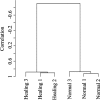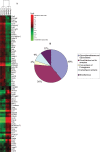Analysis of differential expression of glycosyltransferases in healing corneas by glycogene microarrays
- PMID: 19736239
- PMCID: PMC2782180
- DOI: 10.1093/glycob/cwp133
Analysis of differential expression of glycosyltransferases in healing corneas by glycogene microarrays
Erratum in
-
Analysis of differential expression of glycosyltransferases in healing corneas by glycogene microarrays.Glycobiology. 2019 Feb 1;29(2):188-189. doi: 10.1093/glycob/cwy076. Glycobiology. 2019. PMID: 30508096 Free PMC article. No abstract available.
Abstract
It is generally accepted that the glycans on the cell surface and extracellular matrix proteins play a pivotal role in the events that mediate re-epithelialization of wounds. Yet, the global alteration in the structure and composition of glycans, specifically occurring during corneal wound closure remains unknown. In this study, GLYCOv2 glycogene microarray technology was used for the first time to identify the differentially expressed glycosylation-related genes in healing mouse corneas. Of approximately 2000 glycogenes on the array, the expression of 11 glycosytransferase and glycosidase enzymes was upregulated and that of 19 was downregulated more than 1.5-fold in healing corneas compared with the normal, uninjured corneas. Among them, notably, glycosyltransferases, beta3GalT5, T-synthase, and GnTIVb, were all found to be induced in the corneas in response to injury, whereas, GnTIII and many sialyltransferases were downregulated. Interestingly, it appears that the glycan structures on glycoproteins and glycolipids, expressed in healing corneas as a result of differential regulation of these glycosyltransferases, may serve as specific counter-receptors for galectin-3, a carbohydrate-binding protein, known to play a key role in re-epithelialization of corneal wounds. Additionally, many glycogenes including a proteoglycan, glypican-3, cell adhesion proteins dectin-1 and -2, and mincle, and mucin 1 were identified for the first time to be differentially regulated during corneal wound healing. Results of glycogene microarray data were confirmed by qRT-PCR and lectin blot analyses. The differentially expressed glycogenes identified in the present study have not previously been investigated in the context of wound healing and represent novel factors for investigating the role of carbohydrate-mediated recognition in corneal wound healing.
Figures




Similar articles
-
Detection of differentially expressed wound-healing-related glycogenes in galectin-3-deficient mice.Invest Ophthalmol Vis Sci. 2009 Dec;50(12):5690-6. doi: 10.1167/iovs.08-3359. Epub 2009 Jul 30. Invest Ophthalmol Vis Sci. 2009. PMID: 19643959 Free PMC article.
-
Detection of differentially expressed genes in healing mouse corneas, using cDNA microarrays.Invest Ophthalmol Vis Sci. 2002 Sep;43(9):2897-904. Invest Ophthalmol Vis Sci. 2002. PMID: 12202508
-
Galectins-3 and -7, but not galectin-1, play a role in re-epithelialization of wounds.J Biol Chem. 2002 Nov 1;277(44):42299-305. doi: 10.1074/jbc.M200981200. Epub 2002 Aug 22. J Biol Chem. 2002. PMID: 12194966
-
Genome-wide transcriptional analysis of differentially expressed genes in diabetic, healing corneal epithelial cells: hyperglycemia-suppressed TGFβ3 expression contributes to the delay of epithelial wound healing in diabetic corneas.Diabetes. 2014 Feb;63(2):715-27. doi: 10.2337/db13-1260. Epub 2013 Dec 4. Diabetes. 2014. PMID: 24306208 Free PMC article.
-
Role of galectins in re-epithelialization of wounds.Ann Transl Med. 2014 Sep;2(9):89. doi: 10.3978/j.issn.2305-5839.2014.09.09. Ann Transl Med. 2014. PMID: 25405164 Free PMC article. Review.
Cited by
-
An integrative strategy for quantitative analysis of the N-glycoproteome in complex biological samples.Proteome Sci. 2014 Jan 15;12(1):4. doi: 10.1186/1477-5956-12-4. Proteome Sci. 2014. PMID: 24428921 Free PMC article.
-
Photo-click immobilization on quartz crystal microbalance sensors for selective carbohydrate-protein interaction analyses.Anal Chem. 2011 Feb 1;83(3):1000-7. doi: 10.1021/ac102781u. Epub 2010 Dec 16. Anal Chem. 2011. PMID: 21162569 Free PMC article.
-
Glycan-related gene expression signatures in human metastatic hepatocellular carcinoma cells.Exp Ther Med. 2012 Mar;3(3):415-422. doi: 10.3892/etm.2011.430. Epub 2011 Dec 23. Exp Ther Med. 2012. PMID: 22969905 Free PMC article.
-
Photogenerated lectin sensors produced by thiol-ene/yne photo-click chemistry in aqueous solution.Biosens Bioelectron. 2012 Apr 15;34(1):51-6. doi: 10.1016/j.bios.2012.01.001. Epub 2012 Jan 28. Biosens Bioelectron. 2012. PMID: 22341757 Free PMC article.
-
Potential Value of Datura stramonium Agglutinin-recognized Glycopatterns in Urinary Protein on Differential Diagnosis of Diabetic Nephropathy and Nondiabetic Renal Disease.Chin Med J (Engl). 2018 Jan 20;131(2):180-187. doi: 10.4103/0366-6999.222328. Chin Med J (Engl). 2018. PMID: 29336366 Free PMC article.
References
-
- Almkvist J, Dahlgren C, Leffler H, Karlsson A. Newcastle disease virus neuraminidase primes neutrophils for stimulation by galectin-3 and formyl-Met-Leu-Phe. Exp Cell Res. 2004;298:74–82. - PubMed
-
- Amado M, Almeida R, Schwientek T, Clausen H. Identification and characterization of large galactosyltransferase gene families: Galactosyltransferases for all functions. Biochim Biophys Acta. 1999;1473:35–53. - PubMed
-
- Amano M, Galvan M, He J, Baum LG. The ST6Gal I sialyltransferase selectively modifies N-glycans on CD45 to negatively regulate galectin-1-induced CD45 clustering, phosphatase modulation, and T cell death. J Biol Chem. 2003;278:7469–7475. - PubMed
-
- Brewer CF. Thermodynamic binding studies of galectin-1, -3 and -7. Glycoconj J. 2004;19:459–465. - PubMed
Publication types
MeSH terms
Substances
Grants and funding
LinkOut - more resources
Full Text Sources
Research Materials

